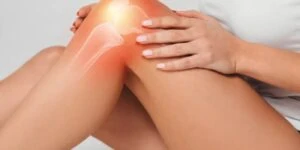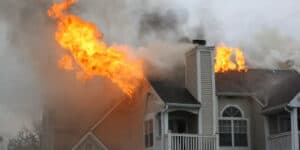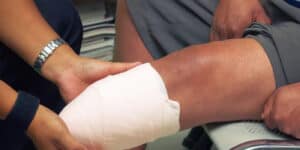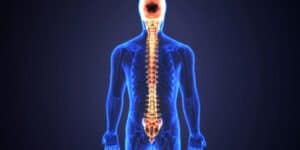
The knee is one of the most frequently injured parts of the body. Motor vehicle accidents, falls, and sports cause the majority of knee injuries. A very complex joint, the knee connects the thigh bone (femur) to the shin bone (tibia). Multiple tendons and ligaments connect the knee bones to the leg muscles controlling movement and stability to the knee joint. Cartilage cushions the bones in the knee joint. Falls, motor vehicle accidents or other trauma can damage any or all ligaments, tendons of bones in the knee joint.
SYMPTOMS AND TREATMENT
Pain and swelling are very common symptoms of a knee injury. Additionally, the knee joint will often feel unstable with stiffness and the loss or reduction in ability to twist, turn, or pivot. Diagnosis is commonly made through a physical examination by a physician or other skilled medical provider. MRI’s or other imaging will commonly be used to confirm the diagnosis and extent of the injury. Treatment can be wide ranging based on nature and extent of the injury. Rest complimented by ice and compression wraps or a supportive brace are commonly prescribed for minor injuries. Major injuries will commonly require surgery and rehabilitation.
For a free legal consultation with a Personal Injury Lawyer
MCL TEAR
The meniscus is cartilage that cushions and stabilizes the knee joint. A meniscus tear is very common and can be very painful, limiting movement. In some cases, the knee can even “lock up” because of the cartilage breaking loose and getting caught in the knee joint. A meniscus tear is a very common injury often associated with sports such as football, basketball, soccer, etc.
A meniscus tear can occur in either contact or non-contact sports. Because the meniscus can weaken with age injuries are especially common in older people. It is also common for meniscus tear injuries to occur at work. Repetitive motion, falls, twisting are all common factors in meniscus injuries. It many cases other structures in the knee may also be affected.
SYMPTOMS AND TREATMENT OF A KNEE INJURY
Symptoms commonly include the following:
- Knee pain
- Swelling
- Stiffness in the knee joint- difficulty bending the leg
- A popping sensation when the injury occurs, coupled with great pain
- Locking of the knee
Diagnosis of a Meniscus tear is made through a physical examination by a qualified medical professional. Often an MRI scan will be utilized to confirm the injury. Treatment for a Meniscus tear will depend on the size and location of the injury. If the tear is small and there is a good blood supply, the tear may heal on its own.
Often however the injury will occur in the inner portion of the meniscus, where blood supply is limited. Rest, frequent icing, compression bandages, and keeping the leg elevated will often benefit the knee and speed recovery.
This will generally be accompanied by over the counter paid relievers such as Advil, Aleve or Motrin. More serious tears often will require surgery, which generally produces good short -term results. In the long term, however, a meniscus injury may result in a higher risk of developing arthritis later in life.
Personal Injury Lawyer Near Me
ACL TEAR
ACL tears are common in knee injuries. It stands for anterior cruciate ligament. Surgery is likely going to be necessary to get the full use of the knee back. Your knee join is made up of a femur, tibia and patella, which is your kneecap. Ligaments connects the bones in your body. Collateral ligaments are on the sides of the knee, with the medial collateral ligament being on the inside of the name, which determines the sideways movement of your knee.
The cruciate ligaments are inside the knee joint, and they cross each other, controlling the back and forth movement of the knee. If you have injured a ligament in the knee, this is called a sprain and there is a spectrum in terms of how serious this is. A grade one sprain is where the ligament is somewhat damaged, with just some stretching but you’re still able to keep the knee joint steady. A grade two sprain is when the ligament is extended so far out it loses its strength, becoming loose, to the point there is a partial tear. This is serious. Grade three is when there is a tear of the ligament, severing it in two, and the knee joint is not able to stabilize itself. This is a very severe problem.
Click to contact our Personal Injury today
COMMON REASONS FOR KNEE INJURIES
- Car accidents
- Bicycle accidents
- Truck accidents
- Crosswalk accidents
- Falls from a roof at a construction site
- Motorcycle accidents
- Construction Accidents
- On the job injuries
- Worksite injuries
- Crane accidents
Knee injuries that occur because of someone else’s negligence, or a company’s negligence, can be life-altering. If you are active, fit, and love to play sports, then suffering a knee injury of any sort can really derail your plans. Worse, most serious knee injuries, especially grade two and grade three ACL tears, do not just heal on their own. Extensive medical care, with the right medical professionals, is needed to get you back to health.
We Are committed to winning and winning big for our clients





